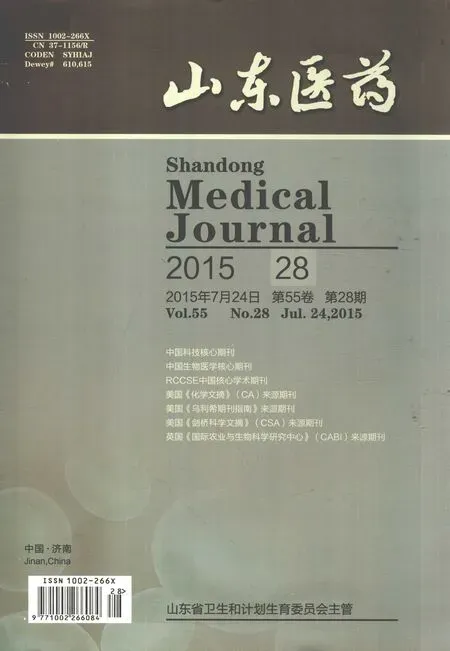用于检测胃蛋白酶原、胃泌素-17的血浆样本保存条件探讨
2016-01-20姚丽娟罗以勤孙安源卜国平王力安徽医科大学附属省立医院合肥230001
姚丽娟,罗以勤,孙安源,卜国平,王力(安徽医科大学附属省立医院,合肥230001)
用于检测胃蛋白酶原、胃泌素-17的血浆样本保存条件探讨
姚丽娟,罗以勤,孙安源,卜国平,王力
(安徽医科大学附属省立医院,合肥230001)
摘要:目的探讨用于检测胃蛋白酶原( PG)、胃泌素-17( G-17)的血浆样本的保存条件。方法血浆样本180例份,采用ELISA双抗体夹心法定量检测血浆PG-Ⅰ、PG-Ⅱ、G-17,作为第1天结果(对照)。将剩余血浆样本随机分为1、2组,每组90份;每组又分为血浆未分离组(离心后未分离血浆)、血浆分离组(离心后取血浆)和稳定剂组(离心后取血浆,并加入稳定剂),每组各30份。将各组每个样本平均分装6管后分别置于室温、4℃和-20℃环境下保存,每天固定时间取1组样本检测PG-Ⅰ、PG-Ⅱ,取2组样本检测G-17,均连续检测7 d(包括第1天)。将室温、4℃、-20℃温度下保存不同时间点时血浆PG-Ⅰ、PG-Ⅱ、G-17浓度与其保存第1天时浓度比较,将P>0.05的天数作为稳定性维续时间。结果血浆未分离组室温下PG-Ⅰ稳定性维持2 d,PG-Ⅱ为6 d,G-17为1 d; 4℃时分别为5、7、3 d;-20℃时分别为4、3、2 d。血浆分离组室温下PG-Ⅰ稳定性维持7 d,PG-Ⅱ为6 d,G-17为2 d; 4℃时分别为5、7、5 d;-20℃时分别为5、7、6 d。稳定剂组室温下PG-Ⅰ稳定性维持7 d,PG-Ⅱ为7 d,G-17为7 d; 4℃时分别为5、6、4 d;-20℃时分别为7、5、4 d。结论在临床标本7 d保存期内,PG和G-17检测样本推荐使用血浆分离后低温保存,如使用稳定剂,推荐血浆分离后室温保存。
关键词:血浆;胃蛋白酶原;胃泌素-17;室温;稳定剂
Storage conditions for plasma samples of pepsinogen and gastrin-17
YAO Li-juan,LUO Yi-qin,SUN An-yuan,BU Guo-ping,WANG Li
( The Affiliated Provincial Hospital of Anhui Medical University,Hefei 230001,China)
Abstract:Objective To investigate the storage conditions for plasma samples of pepsinogen ( PG) and gastrin-17 ( G-17).Methods A total of 180 plasma samples were collected to detect PG-Ⅰ,PG-Ⅱand G-17 as the first day's consequence ( the control group) by ELISA double antibody sandwich method.The remaining samples were divided into group 1 and group 2 with 90 samples in each.Each group was equally divided into the non-separated group with upper layer which was plasma after centrifugation,the separated group with only plasma after centrifugation and the stabilizer group with plasma and stabilizer,30 cases in each group.Every sample in each group was packaged into 6 pipes which were separately stored at room temperature,4℃and-20℃,and we took the samples from group 1 to detect PG-Ⅰand PG-Ⅱ,or G-17 in the group 2 at the same time for 7 days.The concentrations of PG-Ⅰ,PG-Ⅱand G-17 from non-separated,separated and stabilizer groups in the different storage temperatures at different time were compared with the consequences of the first day,and the days of P>0.05 was taken as the maintain time of stability.Results In the non-separated group,the plasma PG-Ⅰ,PG-Ⅱand G-17 maintained the levels for 2 days,7 days and 1 day at room temperature; 5 days,7days and 3 days at 4℃; and 4 days,3 days and 2 days at-20℃.In the separated group,the plasma PG-Ⅰ,PG-Ⅱand G-17 could maintain the levels for 7 days,6 days and 2 days at room temperature; 5 days,7days and 5 days at 4℃; and 5 days,7 days and 6 days at-20℃.The plasma PG-Ⅰ,PG-Ⅱand G-17 in the stabilizer group could maintain the levels for 7 days,7 days and 7 days at room temperature; 5 days,6 days and 4 days at 4℃; and 7 days,5 days and 4 days at -20℃.Conclusion In 7 days of storage for clinic detection,PG and G-17 detection samples are recommended to storage in low temperature after centrifugation,and are recommended to preserve at room temperature if we add stabilizer.
Key words:plasma; pepsinogen; gastrin-17; room temperature; stabilizer
胃蛋白酶原( PG)和胃泌素-17( G-17)在血中浓度的变化可以准确反映胃黏膜消化腺分泌功能的改变,并与胃黏膜组织学变化和病变程度高度相关[1~4],有望成为胃癌的早期诊断标志物。目前,临床上PG和G-17的检测方法较为成熟,但有关样本保存方式、时间和温度等对检测结果的影响报道较少。本研究分析用于检测PG、G-17的血浆样本的保存条件。
1 资料与方法
1.1临床资料选择2012年1月~2014年12月安徽医科大学附属省立医院体检、门诊或住院患者共180例,男104例、女76例,年龄22~87( 48.85± 13.85)岁。
1.2观察方法研究对象均空腹10 h后采集静脉血5 mL,即时上下颠倒试管5~6次,混匀,30 min内离心分离出血浆,取部分血浆采用ELISA双抗体夹心法定量检测血浆PG-Ⅰ、PG-Ⅱ、G-17,作为第1天结果(对照)。将剩余血浆样本随机分为1、2组,每组90份;每组又分为血浆未分离组(离心后未分离出血浆)、血浆分离组(离心后吸取1 mL血浆装入EP管)和稳定剂组(离心后吸取1 mL血浆,并加入稳定剂2滴),每组各30例份。将各组样本分别置于室温、4℃和-20℃环境下保存,每天固定时间1组取5例份检测PG-Ⅰ、PG-Ⅱ,2组取5例份检测G-17,均连续检测7 d(包括第1天)。PG-Ⅰ、PG-Ⅱ、G-17检测严格按照ELISA试剂盒说明书进行。反应结束后30 min内450 nm波长处检测光密度( OD)值,根据已知浓度的标准品计算样本浓度。1.3统计学方法采用SPSS20.0统计软件。计量资料以珋x±s表示,组内两两比较采用独立样本t检验。P<0.05为差异有统计学意义。将三组在室温、4℃、-20℃温度下保存不同时间点时血浆PG-Ⅰ、PG-Ⅱ、G-17浓度与其保存第1天时浓度比较,P >0.05的天数作为稳定性持续时间。
2 结果
三组在室温、4℃、-20℃温度下保存不同时间点时血浆PG-Ⅰ、PG-Ⅱ、G-17浓度变化见表1;三组各温度下稳定性持续时间见表2。
表1 三组在室温、4℃、-20℃温度下保存不同时间时血浆PG-Ⅰ、PG-Ⅱ、G-17浓度变化(±s)

表1 三组在室温、4℃、-20℃温度下保存不同时间时血浆PG-Ⅰ、PG-Ⅱ、G-17浓度变化(±s)
注:与同组保存第1天比较,*P<0.05。
组别 PG-Ⅰ(μg/L)室温4℃ -20℃PG-Ⅱ(μg/L)室温4℃ -20℃G-17( pmol/L)室温4℃ -20℃血浆未分离组1 d 127.74±47.89 127.74±47.89 127.74±47.89 12.78±3.78 12.78±3.78 12.78±3.78 21.08±4.44 21.08±5.44 21.08±5.44 2 d 137.96±51.72 132.71±49.83 132.71±49.83 10.61±6.46 14.70±8.94 11.63±3.08 11.55±3.71*16.57±4.60 16.68±4.56 3 d 160.95±40.34*136.38±31.19 121.36±35.50 10.22±6.22 13.93±2.48 11.37±2.92 6.48±1.51*15.81±3.83 12.03±3.50* 4 d 171.18±44.17*140.52±32.68 113.35±32.46 9.97±2.07 12.14±3.39 8.82±1.17* 3.56±0.23*12.65±2.06*9.08±2.93*5 d 183.82±38.80*148.18±35.56 102.19±28.31*9.71±3.91 11.12±2.77 5.24±1.19* 2.07±0.09*9.91±1.67*6.54±1.71*6 d 189.06±30.88*157.12±28.90*91.97±34.48*9.33±3.68 9.71±3.91 4.09±0.49* 1.10±0.24*8.43±1.38*5.49±1.79*7 d 195.44±33.27*183.94±38.96*83.01±21.14*8.82±3.37*9.33±2.68 1.40±0.86* 0.45±0.06*7.80±1.82*4.21±0.67*血浆分离组1 d 121.12±38.04 121.12±38.04 121.12±38.04 10.39±2.65 10.39±2.65 10.39±3.65 18.80±5.31 18.80±5.31 18.80±5.31 2 d 119.91±37.55 119.91±36.53 119.91±37.48 16.11±3.86*11.64±3.57 12.78±3.41 11.65±2.49 15.97±4.01 16.35±3.32 3 d 116.27±3.12 115.06±3.63 118.70±27.08 13.51±2.95 11.22±3.27 11.53±2.50 9.32±1.70*15.60±3.71 15.98±3.01 4 d 112.64±24.67 107.80±22.75 116.27±26.12 12.16±2.95 11.01±2.11 9.46±1.97 7.89±1.43*13.91±3.33 15.60±2.71 5 d 109.01±23.23 102.95±30.83 105.37±31.79 10.81±3.96 10.71±3.88 8.63±1.35 5.07±0.13*13.34±3.87 15.04±2.25 6 d 107.80±22.75 100.28±29.76*96.90±28.43*9.77±2.19 9.98±2.35 8.42±1.20 4.32±0.52*12.59±3.25*13.34±3.87 7 d 105.40±21.83 94.47±23.47*95.68±21.95*9.14±2.73 9.67±2.12 7.90±0.82 3.95±0.21*12.22±3.95*12.77±2.42*稳定剂组1 d 125.82±29.66 125.82±39.66 125.82±39.66 10.56±2.25 10.56±2.25 10.56±2.25 17.09±3.23 17.09±3.23 17.09±3.23 2 d 123.30±38.87 123.30±37.98 120.79±38.07 10.88±2.47 10.46±2.18 14.37±3.86 16.58±2.83 14.01±2.85 13.84±3.71 3 d 119.53±37.68 119.53±37.78 130.85±41.25 10.35±2.10 10.14±2.96 12.78±2.77 16.41±2.69 13.38±2.56 13.81±3.52 4 d 122.04±28.47 115.75±26.49 118.27±27.28 11.30±2.76 11.83±2.12 10.35±2.10 16.06±12.43 12.65±1.79 12.99±3.05 5 d 119.53±37.18 111.98±25.30 115.75±36.49 10.77±2.39 13.31±3.13 9.19±1.31 15.72±2.17 8.03±1.21*8.55±2.61*6 d 120.79±30.07 108.20±34.11*113.24±35.69 12.47±4.55 14.05±3.64 5.92±1.06*15.38±1.90 5.64±0.36*7.00±1.42*7 d 129.59±20.85 103.17±32.52*111.98±35.30 12.99±2.91 15.42±3.58*4.33±0.97*15.37±1.98 3.76±0.91*6.49±1.03*
3 讨论
血浆PG和G-17检测可以提高早期胃癌的临床诊断率,并能进行胃癌风险评估[5,6]。研究表明,低水平的血浆PG-Ⅰ、PG-Ⅰ/PG-Ⅱ( PGR)与萎缩性胃炎和胃癌的发生呈正相关[7]。血浆PG-Ⅰ、PG-Ⅱ、G-17升高与胃幽门螺杆菌( HP)感染和消化性溃疡关联密切。有文献报道,可将血浆PG-Ⅱ<9.47μg/L或治疗后血浆PG-Ⅱ水平降低1/4作
为判断HP感染治愈的标准[8]。当内窥镜下切除十二指肠肿瘤后,PG-Ⅱ水平显著降低[9]。但是,血浆样本的转运和保存条件、问题样本的复检以及集中批量检测都可能对PG、G-17检测数值造成影响[10]。

表2 三组在室温、4℃、-20℃温度下稳定性持续时间( d)
一般来说,随着保存时间的增加,样本中PG-Ⅰ和PG-Ⅱ抗原效价均会降低,但溶血导致血红蛋白( Hb)溢出,Hb本身具有类似过氧化物酶的性质,能非特异性结合固相使底物显色加深,假性增加PG-Ⅰ、PG-Ⅱ浓度。本研究中血浆未分离组在血浆离心析出分层后,并没有将上层的血浆和下层的血细胞分离,检测时仍采用上层的血浆检测,随着保存时间的延长,会出现溶血并逐渐加重。在室温和4℃条件下,不同保存时间下血浆未分离组PG-Ⅰ呈现连续上升趋势,可能是溶血后血细胞内容物溢出,进入血液的细菌繁殖代谢产生的非特异性吸附导致; 但PG-Ⅱ浓度变化却较小,可能是因为即使存在非特异性吸附的影响,但其本身的基数较低,因此影响也不明显;-20℃温度下PG-Ⅰ、PG-Ⅱ均呈下降趋势,可能与低温降低细菌繁殖代谢速度,延长其稳定性有关[11]。与血浆未分离组比较,不同保存温度下血浆分离组的PG-Ⅰ、PG-Ⅱ水平变化幅度小,其稳定性均能维持5~7 d,说明分离血浆标本可避免血细胞对结果的影响,且温度对7 d内血浆标本内PG浓度的影响不大。在血浆样本中加入稳定剂(酶抑制剂),在室温和4℃温度下PG-Ⅰ和PG-Ⅱ浓度可保持5~7 d的稳定,与稳定剂抑制蛋白降解有关; -20℃温度下PG-Ⅱ在保存第2天出现短暂上升,可能与实验中所用试剂和固相板条产生的系统误差有关。
G-17是由胃窦和十二指肠的G细胞分泌的一种激素[10],极易降解,血浆未分离条件下几乎不能进行样本保存,即使低温延长其2~3 d的稳定性,G-17水平仍然有较大幅度的降低。本研究观察到,血浆未分离组G-17在室温、4℃、-20℃温度下仅维持1~3 d的稳定性;血浆分离组G-17稳定性仍较低,但4℃、-20℃温度下可维持5~6 d的稳定性,可能与低温减缓G-17降解有关。稳定剂组室温条件下G-17浓度可稳定维持7 d,与室温条件下稳定剂抑制G-17降解有关; 4℃、-20℃温度下仅维持4 d,原因可能是低温使稳定剂的成分改变,不利于G-17稳定保存。
在本研究设计之初,曾考虑将稳定剂直接加入到不分离的血浆中观察其是否能更便捷地保存样本,结果发现这样会导致重度溶血,严重影响PG-Ⅰ、PG-Ⅱ、G-17检测结果,甚至测不出数据。此外,还发现分离血浆加入稳定剂后置于4℃或-20℃保存,第2天即出现少量白色絮状沉淀,而室温放置则没有沉淀出现,可能稳定剂的性状不利于低温保存。
总之,在临床标本7 d保存期内,PG和G-17推荐使用血浆分离后低温保存;如使用稳定剂,推荐血浆分离后室温保存。
参考文献:
[1]Kim BC,Jung SW,Kim JB,et al.Serum gastrin levels in different stages of distal gastric carcinogenesis: is there a role for serum gastrin in tumor growth[J].Turk J Gastroenterol,2014,25( 6) : 611-618.
[2]Terasawa T,Nishida H,Kato K,et al.Prediction of gastric cancer development by serum pepsinogen test and Helicobacter pylori seropositivity in Eastern Asians: a systematic review and meta-analysis [J].PLoS One,2014,9( 10) : e109783.
[3]Vannella L,Lahner E,Annibale B.Risk for gastric neoplasias in patients with chronic atrophic gastritis: a critical reappraisal[J].World J Gastroenterol,2012,18( 12) : 1279-1285.
[4]Zoalfaghari A,Aletaha N,Roushan N,et al.Accuracy of pepsinogens for early diagnosis of atrophic gastritis and gastric cancer in I-ranian population[J].Med J Islam Repub Iran,2014,( 28) : 150.
[5]Pasechnikov V,Chukov S,Fedorov E,et al.Gastric cancer: prevention,screening and early diagnosis[J].World J Gastroenterol,2014,20( 38) : 13842-13862.
[6]Nejadi-Kelarijani F,Roshandel G,Semnani S,et al.Diagnostic values of serum levels of pepsinogens and gastrin-17 for screening gastritis and gastric cancer in a high risk area in northern Iran[J].Asian Pac J Cancer Prev,2014,15( 17) : 7433-7436.
[7]Yoon H,Kim N.Diagnosis and management of high risk group for gastric cancer[J].Gut Liver,2015,9( 1) : 5-17.
[8]Di Mario F,Moussa AM,Cavallaro LG,et al.Clinical usefulness of serum pepsinogenⅡin the management of Helicobacter pylori infection[J].Digestion,2004,70( 3) : 167-172.
[9]Yada T,Ito K,Suzuki K,et al.Marked decrease in serum pepsinogenⅡlevels resulting from endoscopic resection of a large duodenal tumor[J].Clin J Gastroenterol,2014,7( 6) : 484-489.
[10]冯仁丰.临床检验管理技术基础[M].上海:上海科学文献出版社,2003: 30-34.
[11]Adams HE,Crump BC,Kling GW.Isolating the effects of storm events on arctic aquatic bacteria: temperature,nutrients,and community composition as controls on bacterial productivity[J].Front Microbiol,2015,31( 6) : 250.
收稿日期:( 2015-03-25)
作者简介:第一姚丽娟( 1978-),女,主管检验师,主要研究方向为临床检验、分子生物学诊断等。E-mail: chinavip166@163.com
基金项目:安徽省自然科学基金资助项目( 11040606M209)。
文章编号:1002-266X( 2015) 28-0018-03
文献标志码:A
中图分类号:R446.11
doi:10.3969/j.issn.1002-266X.2015.28.006
